When seeking online help in diagnosing a
fish disease or parasite, I have found that a great deal of time is
spent trying to properly describe the problem to where others can be of
help. Since a good many fish diseases do not give you, or the fish, a
great deal of time to waste discussing for days what possible issues
are effecting the fish, I have done my best to put together a pictorial
guide in the hopes that it will allow you to better identify exactly
what is ailing your fish.
If you are able to identify a disease or parasite on your
fish,
and have a good photograph, please submit it for use within this
webpage in order to allow others a better chance at correctly
diagnosing the same problems you have encountered. To do so, please use
my contact page. Thank you.
Also available for corals
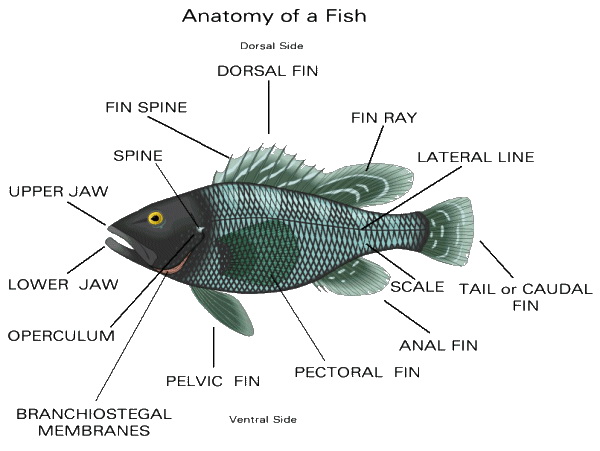
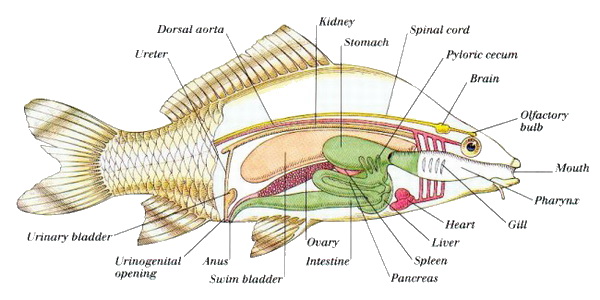
Generally,the oceans can be considered a somewhat stable
environment that experiences limited fluctuations within its water
parameters, such as salinity, pH and temperature. It is due to the
upper and lower limits encountered on a typical tropical reef that most
of its inhabitants are unable to tolerate any extremes that may occur
above or below their normal swings.
As such, we must ensure that our aquariums do not experience
rapid or extreme differences to what can be found in a natural tropical
environment. When we transfer creatures from their native habitats to
aquariums, we must consider that everything must be within their
naturally occurring tolerances, there is little room for error. The
following concerns should be taken into account when maintaining your
aquarium and with the stocking of its inhabitants.
Please take into consideration -
1 - Water quality.
This area of aquarium keeping is of great importance for
obvious
reasons and covers a wide range of parameters which you must become
familiar with and able to provide to the occupants of your aquarium.
Providing the proper environment is of course critical to the health of
any organism placed within our aquariums. When your fish
encounter a problem, the quality of their water should be the first
item on your check list as to possible causes of poor health.
2 - Compatibility.
Many reef fish such as the damsels and angelfish are territorial,
vigorously defending either an individual or a pair's territory against
all other fish, especially con specifics. This
behavior, essential on a highly populated reef, may cause problems in
the confines of small aquariums, stressing not only the other tank
inhabitants, but also the territorial individuals themselves who will
be unable to drive the "interlopers" from their territory. An
alternative lifestyle is that of shoaling where the fish congregate in
large schools thereby reducing the chances of an individual being
predated, but also helping to maximize the use of certain food
resources and to increase the opportunity for male-female interactions
for spawning. A classic example of these would be the Anthia and
Chromis species.
However due to the low stocking densities of marine aquaria, the
relatively high price of individual fish, and the tendency for many
aquarists to want "one of each" these fish are rarely kept in the
correct social numbers or groupings.
Not only must we consider the compatibility
between fish
species, we
must also take into account other various life forms that are commonly
kept within a reef setting. Many anemone species are very capable of
capturing and consuming fish. There are many coral species that have
powerful stinging capabilities as well, while not usually a problem for
most fish, it can become a health issue if a fish picks an
area to spend the night that is within stinging reach of any number of
corals. While the stings themselves may not kill the fish, they can
open wounds which are then easily invaded by other pathogens such as
bacteria. In larger tanks, this occurance of being stung is very rare
since there is usually ample rock that provides caves / crevices well
out of reach of corals that are usually placed on top of the rocks and
towards the front of the aquarium. In small aquariums, the risk becomes
greater as space becomes a premium.
 A foxface that has slept a little too close to a coral. Which
the
fish should then be placed within a quarantine type tank and treated
with an appropriate antibacterial medication to prevent infections. The
landscape of the show aquarium should also be arranged to remove any
corals or anemone that may pose such dangers to fish
during the night.
A foxface that has slept a little too close to a coral. Which
the
fish should then be placed within a quarantine type tank and treated
with an appropriate antibacterial medication to prevent infections. The
landscape of the show aquarium should also be arranged to remove any
corals or anemone that may pose such dangers to fish
during the night.
3 - The vast majority of marine fish and
invertebrates are wild
caught. This means that they all come with a certain amount of baggage
in the form of parasites, bacteria, viruses and the like, which all
wild
fish carry and live in balance with.
If we take all the above into consideration we can see that
there is a recipe for disaster. If one buys an apparently perfectly
healthy fish, if it is wild caught, one
must assume that it will be carrying something somewhere and there is
little that can be done about it, and the fish must be placed into
quarantine for observation.
Certain treatments actually cause problems such as
penicillins
inducing blindness in clownfish, whilst many diseases have no known
cure as yet. What we have got some control over is the environment
within the aquarium. With correct husbandry
techniques we can maintain the water quality at its optimum, feed the
right foods and provide the correct social environment such that the
fish are able to function at their best and will be able to control any
unseen or unknown pathogens with their own immune systems.

Temperature.
- This should be as close to the fishes' natural environment as
possible. Fish (and invertebrates) are ectotherms reliant upon heat
from their surroundings to support their metabolic processes. At low
temperatures their immune systems are compromised, as are other
processes such as their metabolism, digestion and drug
absorption.Excessive high temperatures will reduce the oxygen holding
capacity of the water and stress the fish.
When using treatments, it has been shown that lower
temperatures
(76-78) increases the effectiveness of anti-bacterial medications as
well as slowing down the growth rate of bacteria as well as possibly
slowing down the reproductive rate of some parasites. These lower
temperatures should not be maintained any longer than necessary for
treatment.
Salinity - The water
surrounding a marine fish is
more concentrated than the body fluids of the fish and so osmosis
constantly draws water from the fish. This is why Hypo salinity during
quarantine (only do so for fish only) reduces stress on fish since
their bodies do not have to work as hard against osmotic pressures.
To prevent dehydration, saltwater fish must drink, with the
salt
that they imbibe
being excreted via the mucus secreting glands of the skin,in the feces,
but primarily from the kidneys and the gills. Sudden raising of the
salinity will dramatically upset this delicate balance stressing or
even killing the animal. Please DO NOT lower your aquarium's salinity
level below normal in the mistaken belief that in doing so is good for
the fish over the long term, it is harmful to the fish, causing kidney
failure.
Oxygen level
- The amount of dissolved oxygen is determined by the atmospheric
pressure, the temperature and the salinity. Extreme temperature or
salinity will reduce oxygen levels, often to dangerous levels.
pH
- Saltwater has a pH of around 8.0 to 8.3, and has a significant
intrinsic buffering capacity. However CO2 and other metabolic
byproducts from the aquarium inhabitants will tend to reduce the pH.
This will to some extent be resisted by the normal buffering
mechanisms
but these can be exhausted allowing a rapid fall in pH. In tanks with a
heavy algal growth, during the period of illumination the opposite may
occur where all the available CO2 is utilized; bicarbonates are then
used for photosynthesis resulting in the precipitation of carbonates
and a rise in pH. This is why it is important to take your pH test at
the same time of day/night each time you take a test. Running your
sump's refuge area's light on an opposite cycle of the main tank can
reduce this pH swing between daytime and night time.
Environmental Toxins
- These include ammonia, nitrite, heavy metals, chlorine and
chloramine. Ammonia is particularly important because at the high pH of
marine aquaria it is mostly in the more toxic form of NH3.
Should one be correcting after a fall in pH, bear this in
mind
because as you
raise the pH a significant amount of ammonia present will convert to
the toxic NH3. Of the heavy metals, copper is probably the most
important because it is toxic to invertebrates at low concentrations
and to fish at higher concentrations, yet it is an important
constituent of many off the shelf medications. Copper can bind to
rock work in the aquarium, only to be slowly released at a later date,
a
fact which can result in invertebrate die-offs some time after copper
containing medications were last used. Fortunately copper test kits are
readily available.
Another area of concern is within the outer
environment of the fish,
namely the room / air that the aquarium is in. I have heard of many
cases of having entire livestocks killed by the inadvertent use of any
number of chemicals, solvents, smoke, aerosols and paint fumes either
within the room, the house and even something as simple as the neighbor
spraying his yard with pesticides, as well as having cleaning
chemicals dropped into the aquarium while cleaning.
The top of an aquarium should never be used as a shelf to
put
your cleaning
solvents, soaps, foods or additives on while you go about your chores.
An accident waiting to happen is putting it mildly. You should take
your aquarium into consideration when using such items.
Clownfish HyperMelanization -
This seems to be a
common occurance with clownfish that host corals. I assume that since
clown fish's skin is adapted to dealing with
the stinging power of anemones, the darkening of the skin is a response
in trying to deal with the foreign mucous and stings of
corals. I have
never seen this condition become a problem for the fish and
they
seem to do just fine.

Nutrition
-
(Article has coral feeding needs also) Probably one of the biggest
causes of problems developing within fish
It is extremely important to study the fish species you have
in
mind for your tank BEFORE you get it. If a fish is not receiving its
proper food source(s) it is most likely not receiving its proper
nutrition, which will weaken the fish thus making it much more
susceptible to opportunistic diseases.
If a fish has a specific diet, such as algae, or copepods,
you
must ensure you can provide that diet well before you get the fish. For
those fish that require live
food but have been known to be trained to eat prepared foods, the
training is much easier to accomplish within a quarantine type setting.
If you have its original food source available to supplement
its
feeding with during the training, in the event it does not take to the
prepared foods it will not starve to death. Keep in mind also that in
your attempts to feed a finicky eater, you may well
also be polluting the tank causing water quality issues which can lead
to another susceptibility issue. Frequent testing of the water should
also be done.

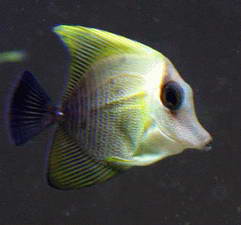
Acclimation Stress
- Often confused with an internal bacterial disease which appears
very similar, the improper acclimation of marine fish can cause
capillary congestion leading to the rupture of the capillarys through
sudden exposure to higher salinity levels. This is most often
seen with newly purchased fish that have not been acclimated very
slowly, as in days long periods to higher salinity or when replacement
water is above the aquarium's salinity when performing a large water
change. As long as the fish is eating properly and it develops no
other problems, it should heal in due time and recover. If the
fish develops such red markings in the absence of salinity changes then
I would suspect a bacterial infection due to poor water quality and the
fish should be removed and treated by feeding it an anti-bacterial
laced food while taking steps to get the organic levels of the aquarium
under control.

EARLY WARNING INDICATORS -
Most of us, once we have
kept fish for awhile can tell when they are not feeling well, sadly
though, by the time we do notice something is wrong, it may be too late
since fish will appear or act as normal as possible for as long as
possible, which I feel is a natural survival technique, since within
the wild, any fish that shows any sign of weakness is quickly singled
out for predation. Thankfully though, there are visible signs that we
can watch for and take action before it does become too late.
A few things to be aware of or watch for:
- Loss of appetite, common among newly acquired fish due to stress, but
if a normally active feeder stops, then it may be a sign of things to
come.
- Discoloration , not to be confused with a fish's catatonic state in
the dark or when frightened.
- Rubbing against objects, usually a first indication of a skin
irritation / infestation.
- Rapid breathing , usually indicates an infestation of the gills which
can inhibit oxygen exchange, it can also be water quality related, such
as high ammonia levels or lack of aeration.
- Lack of movement, if the fish remains in one spot, resting on the
bottom or hanging out near the surface can indicate an illness.
- Clamped fins, keeping its fins laid down or held closely to its body.
- Mucous or other obvious signs such as spots, specks or growths
appearing on the skin or fins of the fish.
- Droppings that are out of the ordinary, undigested food, blood or
otherwise abnormal in appearance.

For all of us who keep marine fish as pets, we should be
prepared to be able to treat for any diseases and parasites that may be
encountered. Finding out that your pet has a problem and having to wait
for a store to open or a shipment to arrive can frequently cause the
death of the fish.
Many pathogens are very quick acting and do not allow us to
wait. As such, here is a basic first aid kit that we should all keep on
hand and of course, stored safely just as you would any medication or
hazardous chemical.
I would also like to suggest that you check with your local
veterinarians if any of them have experience with treating fish, besides
being able to do skin scrapings and culture for the results, thus
giving you an accurate diagnosis, they can also prescribe
medications not normally available through store outlets.
- A quarantine tank and all
associated equipment standing by for immediate set up and use.
- Assorted measuring devices such as old unused, marked test
kit vials, plastic syringes.
- A refractometer to accurately test the salinity since the
use of hypo salinity is of great use to us.
- Dipping containers / bowls.
- Copper test kits.
An assortment of medications to include but not limited to :
- Formalin 3 - Treats and cures a wide variety of bacterial,
fungal and
parasitic problems, for some parasites, such as brooklynella, this is
the only effective treatment.
- Cupramine - a copper based product useful against marine
ich and marine velvet.
- Maracyn 2 - an anti-bacterial product.
- Malachite green - effective anti fungal product.
- Methylene blue - useful with freshwater dips.
- Neomycin - anti bacterial.
- Pipezine - dewormer.
At the bottom of this page is a list of a wide
range of
medications available, having an assortment of products available on
hand will increase your choices of treatment plans.
Please note:
Be very careful with your medication / treatment plan as scaleless
fish do not tolerate various chemicals.
Cryptocaryon irritans
(Marine Ich) Usually billed as the marine equivalent of white spot, the
parasite usually presents itself initially by causing a loss of
appetite, some skin irritation and minor respiratory distress.
Closer investigation will reveal pinhead-sized white to gray
nodules. The parasite causes excessive irritation resulting in
reactionary growth of the skin surface, these growths are what you see
as very small white spots.The parasite is highly infectious and
often fatal within three to five days.
The life cycle is complex and will continue in the aquarium
until all the fish are either dead or develop a partial immunity. Do
not confuse this parasite with the brooklynella parasite which may
cause similar skin reactions seen after the first indicators
of brooklynella, which are cloudy eyes and excessive skin mucus being
produced. Please see the link provided.
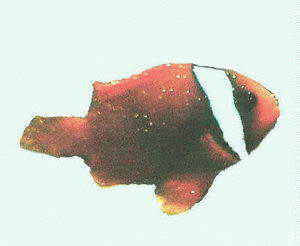
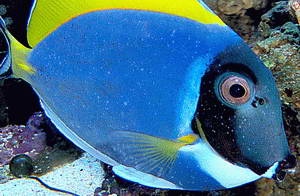
Amyloodinium
Also known as Velvet. This is a rapidly progressing disease which
starts off at the gills and so shows initially as respiratory distress
but will then spread out across the skin.
Signs include respiratory distress, skin rubbing and erratic
swimming. Without treatment death can occur within two days of
respiratory signs. This is an additional
link concerning identification and life cycle. Hypo Salinity
treatment is not effective.


Turbellarian
or "black ich" is caused by one or more genus of flatworm, with
distinct life cycles as you see with the true marine ich. The only
obvious signs of this parasite are the dark spots which is a skin
reaction of the fish being attacked by the parasite and is not the
actual parasite. As you can see in the below photo, this
flatworm
parasite can also infest other invertebrates such as this yellow sea
cucumber. Yet another very good reason to quarantine
everything
before it goes into your main aquarium system.

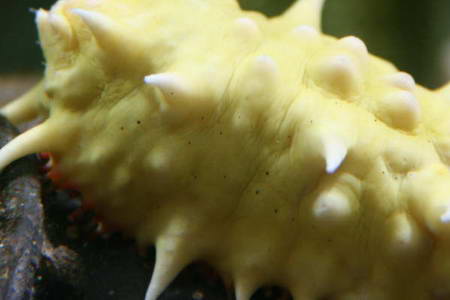
Brooklynella
- Similar in appearance to Uronema, these protozoa seem to be
increasing in importance. The infections are initially confined to the
gills but eventually will spread causing tissue irritation and skin
slough producing ulcers.
Fish become lethargic and secrete excess mucus. Death can
occur
within twelve hours from toxins released by the protozoa. First
indicators can include heavy breathing, cloudy eyes, excessive mucus
and Ich like lesions. This parasite must be dealt with very quickly!!

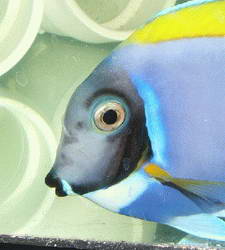
Cryptosporidium nasoris is a coccidian
protozoan
which attach to the lining of the guts of fish. Hoover et al. (1981)
described this species from 8-cm long naso-tang, Nasolituratus
Bloch & Schneider originating from a pet store in the
USA and kept within a marine aquarium.
Histological examination and electron microscopy of
intestinal
mucosae revealed organisms resembling members of the genus Cryptosporidium.
Infected fish show emaciation, loss of appetite, regurgitation and
droppings with undigested food in them.
Other coccidia can invade the gall bladder, liver kidneys
and
even the
gonads, effectively neutering the fish. Over sixty species of
myxosporideal protozoa have been reported in marine fish. One
particular one, Glugea heraldi, forms whitish cysts just under the skin
on Atlantic seahorses.
Myxobolus
parasites are another common infestation of wild caught marines. Indeed
most tropical marines harbor Ceratomyxa, Myxidium or Leptotheca in
their gallbladders. Septemcapsula plotosi and M. Cerebralis have been
found to infect the nervous tissue of fish causing the fish to whirl
before death. There is no known cure for this problem.
Uronema Marinum - U. marinum are
single-celled,
microscopic, ciliated, opportunistic invaders that normally feed on
bacteria in the aquatic habitat.
They are constantly in an energy acquisition phase (always
looking for food. When the fishes immune system is stressed, U. marinum
will attack the fish, invading muscles and internal organs, eating red
blood cells and other cells. Uncontrollable or recurrent infestations
are typically indicative of underlying problems such as introduction of
new fish, overcrowding, and poor water quality.
Life cycle.
This takes place by simple mitotic division, but there seems to be
quite a body of evidence that in marine Aquariums at least, that high
organic loads appear to favor the reproduction of the ciliate.
The below picture is a necrotic wound caused by this
parasite.
The parasite can be confused for brooklynella which if treated is not a
problem in misidentification since the usual formalin treatment will
destroy both types of parasites.
This parasite is just as deadly and as quick acting as
brooklynella and will remain viable for some time even after the fish
has died.



Most bacterial diseases of marine fish are secondary
opportunist
infections, secondary to such stress as poor water conditions,
transportation and wounds.
Internal Bacterial Infections
- Usually shows itself as bloody patches or streaks visible in the
fish, this type of infection requires the fish to be removed to a
quarantine tank for treatment of both its water and its food to ensure
a speedy recovery. Please DO NOT attempt to perform treatments in the
main tank.
While being treated within the quarantine tank, feed the
fish a
medicated antibacterial fish food such as Gel Tec. For an initial
treatment plan, I would at first, go with a medication that targets
gram-negative bacteria as these are the most commonly experienced
problems. Such medications include Maracyn 2 or a sulfa based
medication.
If after the prescribed treatment period, it is found to be
ineffective, I would then switch to a gram-negative medication such as
Erythromycin. Please note that it is extremely important that you
perform each and every treatment period to the end of its prescribed
length of time. If not, by subjecting bacteria to short dosage periods,
you could be creating a medication resistant strain of bacteria, which
would be even more difficult to eradicate. Also, never mix any
medications regardless of any manufacturers claims of being able to do
so.
If you do find that you need to change to a different
medication, do a partial water change and run carbon to remove any
traces of the previous medicine before adding a different one. Even if
the fish looks much better, never stop the treatment until the
completion of the prescribed treatment time.
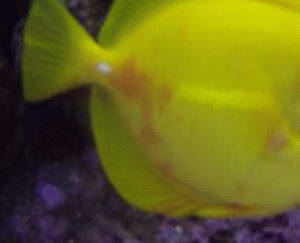

Fin Rot.
Evident when the fins show degeneration and start to look ragged in
appearance. The most common cause of fin rot is physical abuse,
followed closely by poor water quality.
The bacteria responsible for further fin loss is a gram
negative
bacteria and can be treated in a quarantine tank with an appropriate
anti-bacterial medication.

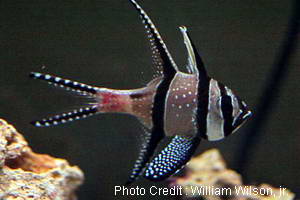
Pop Eye /Cloudy Eye.
A very obvious swelling and / or cloudiness of the eyes, this is most
often caused by poor water quality or physical damage or abrasion to
the eye of which secondary bacterial infections can take advantage of.
This is another gram negative bacteria responsible for this
condition and can be treated in a quarantine tank with an appropriate
anti-bacterial medication. As with all fish
problems, stress is the leading cause of illness, usually water quality
can be blamed. In good water quality, this condition most always
disappears on it own without further treatment. For extreme cases, as
shown in the photo, a medicated treatment would be advised.
Treatment per Dr. A.J. Meyer - Using
a small container, place 4 liters
of tank water and add 1 ml of a 10% solution of Baytril oral
solution (enrofloxacin). Place the fish in for 60 minutes at a
time
once daily with an airstone and repeat for 5
consecutive days. The same water can be re-used each of the five days.
This medication or solution should be available by prescription from
your local Vet.

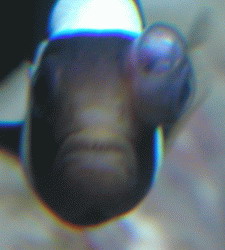

Photo Credit : Kelly Jedlicki
Photo Credit : Kelly
Jedlicki
Photo Credit : Chuck Purdy
Vibriosis.
A rapidly progressing septicaemic infection characterized by skin
hemorrhages, lethargy, anorexia and the eventual formation of deep skin
and muscle ulceration.
Definitive diagnosis and treatment is based upon culture and
sensitivity tests. A commercial vaccine, produced for salmonids, is
available and would be worth considering if Vibrio became a recurring
problem.
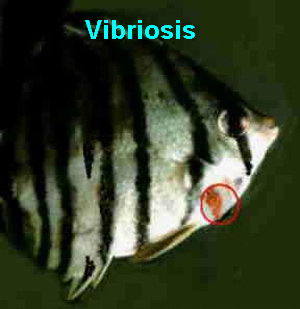
Pasteurellosis. This presents as a
haemorrhagic
septicemia similar to Vibriosis. Should the fish survive this then
grayish-white granulomatous lesions form in the spleen, liver and
kidneys - a condition known as pseudo tuberculosis. Treatment is with
appropriate antibiotics.
Fish Tuberculosis.
Very common in marine fish. Granulomatous lesions due to the
mycobacteria can affect any organ and so the fish may present with
emaciation, ulceration, anorexia, loss of color, respiratory distress
or exophthalmia.
Laboratory diagnosis is essential especially because of the potential
risk to the aquarist.
Other bacteria may occasionally be isolated including Edwardsiella,
Aeromonas, Pseudomonas, Streptococcus, Flexibacter or even Eubacterium
tarantellus - this latter bacterium affects the central nervous system
causing altered pigmentation and swimming patterns.

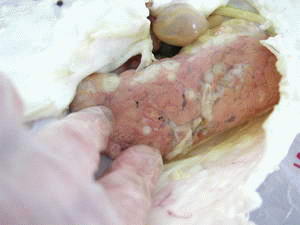
External Lesions
Note TB nodules on the liver as well as worms
Photo Credit :
Kelly Jedlicki
External (Gas?) Bubble Disease
- I believe these formations can be caused by two distinct, separate
aquarium conditions. In the below photos, the bubble formations appear
to be fluid filled, in this case, a bacterial infection would be
suspect.
Just as with "pop eye", an aquarium with high organic
levels, or
the use of crushed coral as a substrate provides the conditions for
bacterial growth, in such high numbers, the
bacteria can quickly overwhelm the fishes immune system or invade the
fishes protective mucus coating.
This condition should see the fish removed to a quarantine
tank
for treatment with an antibiotic while the aquarium receives a
filtration or substrate make over. Increased water
changes will help in the short term, but one must look at the entire
system and the amounts of food being fed to the system.
If the bubble formations appear to be shiny, then
most likely there is an actual gas involved. This can occur when the total
dissolved gases
within the water reach a super saturation level. Heavily aerating the
water can lead to conditions where the water holds a great deal of
dissolved gases which then comes out of solution within the fish and
forms actual gas bubbles, some of which will appear externally on the
fish as well as the fish having internal formations as well.
Higher temperatures or a sudden increase in temperature can
bring gases out of
solution. To cure this problem, you may want to reduce or slow down the
amount of aeration the tank is receiving and ensure the water
temperature maintains within normal parameters.
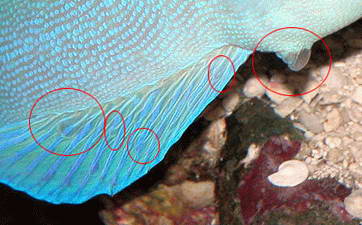

Photos provided
by Matt Pedersen of MarineBreeder.org
MYCOBACTERIOSIS -
Emaciated appearance along the narrow, dorsal edge. A sunken belly
becomes noticeable, although bloating (ascites) may also occur, due to
fluid accumulation in the body cavity.
Unilateral or bilateral exopthalmia (Popeye) are common
symptoms, as well as lifted scales, pale coloration, and in advanced,
chronic cases, spinal curvature. All this soon leads to a loss of
appetite, jerky swimming, greatly reduced reactions and
reflexes.
Ultimately, the affected fish becomes lethargic, seeking the
corners of the aquarium, appearing to want to remain apart from it's
tank-mates until it dies. Quoted from Mr. Lance Ichinotsubo.
As is the case with any of the bacteria, they are opportunistic and
will take advantage of what other diseases have done to the fish
causing secondary infections. The below photos show this
bacterial strain having done so as confirmed by laboratory
identification as being a Mycobacterium.
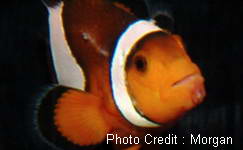

Mycobacterium marinum - This
bacterial strain is a very real and present danger to ourselves and has
the greatest potential for human contraction with a disease associated
with their aquarium.
SAPROLEGNIA
- (FUNGUS) - Fungal disease in tropical fishes is
associated with adverse environmental conditions. Infection, whether
occurring in isolated individuals or in epidemic proportions, is
preceded by some environmental stress that disrupts the normal host
defenses.
Most of these infections are attributed to members of the
genus Saprolegnia.
These organisms, considered to be saprophytic "water molds," are a
normal, ubiquitous component of aquatic ecosystems. Saprophytes live
off of decaying organic material and are essential for recycling
nutrients back into the environment.
If you have ever seen a piece of fish food left in the
aquarium
and was covered in what looks like cotton, those are all fungus
filaments doing their job of breaking down
organics, the problem is when they start trying to break down your
living fish and can also appear as cottony growths on the fish as well.
Fungal infections can be unseen killers if the gills are
infected, which may happen if another pathogen such as a parasite has
damaged the gills allowing the fungus to gain access.
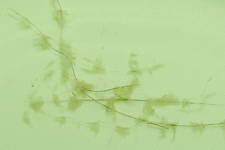

Individual fungal filaments
Severe case on Tail area

Viruses appear to be very common in fish although not all are
associated with disease. Treatment is rarely practical aside from
provision of optimum conditions to allow the fishes' own immune system
to deal with the infection.
Lymphocyctis virus.
This virus induces massive cells to form which appear grossly as
grayish-white masses on the fins and gills. Such abnormal cells may
also be found in the muscle and body cavity.
May be confused with chlamydia infections (epitheliocystis),
parasitic cysts or sarcomas. Infections are usually self-limiting and
may spontaneously clear of their own accord.
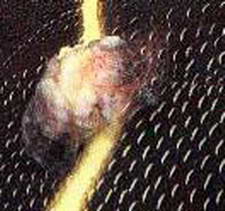
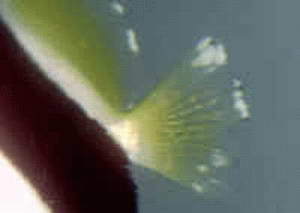
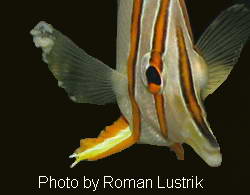
Cell Masses on body
Note
fungus like appearance on fins

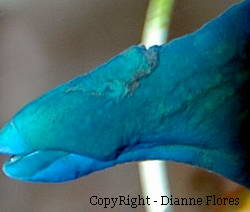


Lymphocyctis on a
cowfish
Tang Fingerprint Disease. Oval
fingerprint-like
areas of discoloration occur on the sides of tangs and surgeon fish.
Fish feed well at first but deaths can occur. Given ideal conditions
the disease appears to be self-limiting.
Initially thought to be a result of traumatic damage,
microscopic investigations failed to confirm this; it is believed to be
viral although no viral particles have yet to be identified.
Infectious Pancreatic Necrosis Virus.
Usually
considered a disease of salmonids IPN virus (or to be precise, a virus
indistinguishable from IPN) has caused disease in over twenty different
species of tropical marine fish.
In an outbreak the fish lost appetite, became lethargic and
eventually disorientated. Some became ascitic and hemorrhages at the
base of the fins were common. Unlike in salmon there was none of the
classic necrosis of the pancreas.
Angelfish Encephalitis. Seen in French
and gray
angelfish, affected fish become lethargic, lose their appetite and
secrete excess mucus. Eventually they lose their balance and die. There
is no known treatment or control measures.
HLLE or "head,lateral line erosion"
Head and lateral line erosions seen in marine fish. Associated with an
aquariovirus. Usually starts out as visible pitting (holes) around the
eyes and along the lateral line. Better water quality and diet usually
allow the fish to fully recover.

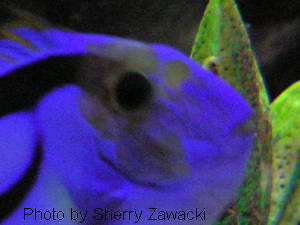


Turbellarian flatworms
have caused skin damage and eventual deaths in yellow tangs. Other
species affected included surgeon fish, angelfish, butterfly fish,
parrot fish and wrasse. Outbreaks are associated with poor husbandry
and high levels of organic matter in the aquarium.
Monogenean Parasites
are
better known as flukes or flatworms, which live as parasites on fish
usually infesting the gill areas first. Being monogenean means that
they have one direct life cycle and do not need an intermediate host to
multiply. These parasites are usually transmitted by direct contact
between fish.
Long term treatment methods such as formalin baths will be
needed since the eggs of these parasites can survive initial one time
treatments. Most are commonly located on the skin and in gill chambers
and more rarely in the mouth and body cavities. They use hook
attachments to grip the epidermis whilst feeding on the skin and gill
tissue; this causes only superficial damage.
More importantly they can cause epidermal ulceration after
heavy
feeding thus in numerous quantities can in fact cause heavy damage.
They are also thought to transmit other pathogens. Treatment should
include antibacterial medications to prevent secondary infections as
shown in the fish below.
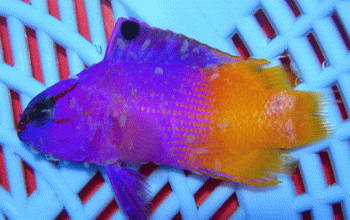
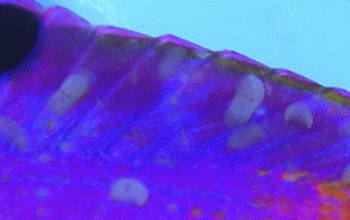
Monogenean
Flukes, Please see the above link for more details and treatment
options.
MONOGENETIC TREMATODES
(Monogenetic = direct life cycle) of the genera Gyrodactylus
and Benedinia
occasionally cause problems.Often near the eyes or gills, affected fish
show signs of heavy respiration and scratch against objects in the
aquarium.
Some fish may hover in the water with their fins clamped
tight
against their body. The eyes may be inflamed - the trematode Neobenedenia
can cause corneal ulceration with eventual functional loss of the eye.
Diseases caused by tapeworms and nematodes are relatively
rare
in aquaria, because in the majority of cases an intermediate host(s) is
required in the worm's life cycle - a stage from which the fish will be
isolated in the aquarium. Encysted stages or living worms may be found
in fish. Some species may have an ability to switch to a direct life
cycle - for instance Spirocamallanus which has been
found in 16 species of tropical marine fish in Hawaiian waters, can
prove to be a problem in aquarium fishes.
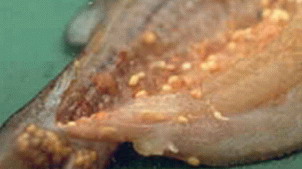
Heavy Trematode Infestation

NEMATODES or internal roundworms, while
somewhat
rare in captive bred fish since most worms need an intermediate host
for the life cycle, the same can not be said of wild caught specimens,
which in our hobby makes up the bulk of our available species.
Our marine tropicals are most likely able to bring home a
variety of problems with them. A medicated fish food should be used to
administer the medication. As a suggestion, Hikari makes a product
called Prazi-Pro in which the active ingredient is Praziquantel, also,
Gel-Tek makes a product called Ultra Cure PX, which contains
metronidazole, flubenol and praziquantel, all of which are de-wormers.

Besides a "bloated" belly, having the fish
discharge a "stringy"
appearing excrement is usually the only first indicator that we will
have of an internal roundworm problem. Although such a "stringy"
appearance may also only be an indication that the fish needs a more
meatier diet as well.
The lack of any truly visible signs of such an infestation,
is a
very good reason to assume that all newly purchased / caught fish are
infested with worms and should be medicated as such while they are in
their mandatory six week quarantine period.
The severity of nematode infestation in fish will
vary depending
upon the life stage, species, and number of nematodes present; the age
and species of infected fish; and the sites of infection.
Even though adult nematodes are typically found in fish
intestinal tracts, adult and other life stages can be found in almost
any organ, but they are most commonly
present in muscle, the liver, and tissues surrounding the internal
organs.
Visible signs of infection may include hemorrhaging, cysts
or
granuloma formation (a granuloma is a reaction by immune cells in which
the cells try to “wall off” some foreign body, in
this
case, the worm. Granulomas formed around worms can look like little
brown “rock-like” areas in the shape of the worm,
but will
be surrounded by a distinct clear area at their very edge), external
lumps or nodules, inflammation, and necrosis (presence of dead and
dying tissue.
Adult nematodes in the intestinal tract damage its lining
and
rob the fish of nutrients, causing a "wasting" effect. These are the
only types of roundworms that we can treat for, any worms outside of
the intestinal tract are for all purposes, untreatable.
Feeding our fish live foods or fresh seafood can transfer
worms
to our fish, as
such, I freeze all fresh foods to ensure any and all worms are killed,
I would also avoid feeding live food such as other fish to our larger
predatory fish.
For treatment, a medicated food such as an anti-parasitic
food by
Jungle that contains
Praziquantel, levamisole and metrodinazole. The first two medications
will deworm and the last one will work against intestinal protozoans.
Another product call Ultra Cure PX by Gel-Tek can also be used.


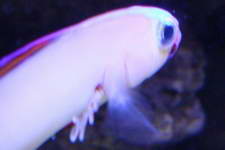
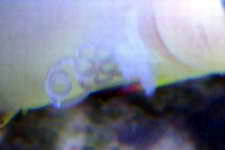

Quote Leslie Harris "
An internal copepod parasite called Serpentisaccus magnificae which lives on the
orange fire fish Nemateleotris magnificae. What you have appears to be the same
or a similar parasite. The genus name of the parasite - Serpentisaccus -
describes the 2 long curly egg sacs. The rest of the body is deeply embedded in
the fish's body. Even if you pull off the egg strings, unless the parasite is so
damaged that it dies it will just grow new egg sacs. This type of parasite
usually doesn't kill the fish and if the fish is healthy it should be able to
tolerate the parasite. The life cycle of this parasite isn't known. Similar
copepods go through up to 11 developmental stages starting with planktonic forms
before they become the final adult form. Some species require an intermediate
host like a snail but others don't; once they stop being planktonic they find a
host fish to live on. Without knowing the life cycle it's impossible to predict
if the eggs can survive long enough to become additional parasites. Hopefully
they will be eaten or removed through your tank's filtration. these parasites
tend to be very specific about which fish they live on so it's unlikely that
they would attach to any other fish in your tank." Unquote.
Below : Various Copepod and Isopod parasites


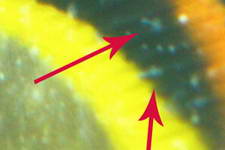
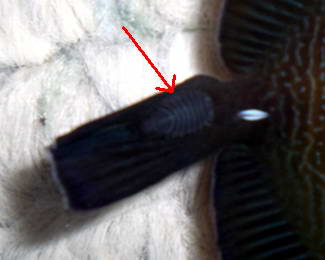
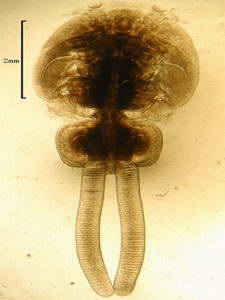

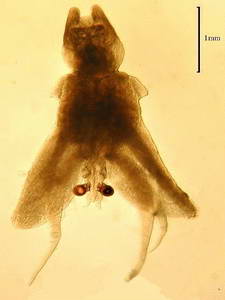
Caligidae
(copepod)
Hatschekiidae (copepod)
Lernanthropidae (copepod)
This group includes some "old favorites" such as
the fish louse Argulus sp. which may
occasionally turn up. Parasitic copepods may
be seen, often near the eyes or gills. The isopod parasite
Icthyotaces pteroisicola
has been reported to cause marked skin swellings on the lion fish
Pterois lunulata, each swelling acting as a protective sac for one
parasite.
For large obvious Isopods attached to the fish as shown above, manual
removal would be best, which can be done with a pair of tweezers or by
placing the fish in a dip solution.

When it comes to curing a fish, there are only two
methods
available to us, either Chemotherapy or Environmental, both of which
have their place,
but never within our tanks.
All treatments must be performed outside of the main tank
within a Quarantine Tank.
As long as there are hobbyist who insist on rushing home with their new
purchases and putting them directly into the main tank, then there will
always be disease and parasite problems.
All large aquariums throughout the world all have strict
quarantine procedures in place for a reason. It works!.
Besides using a medication for a treatment, you should also
provide pristine water conditions to reduce any stress on the fish as
well as not giving the pathogen its suitable environment (organic
laden).
Keeping the tank's temperature on the lower end (low to mid
70's) will hinder
the growth of most pathogens and may allow medications to be more
effective. Also keeping the salinity lower (SG 1.018) helps with
oxygenation as many antibiotics "work" better in lower salinities as
well.
Stress reduction is very important at this point as stress
will
increase the fish's metabolic rate which increases the oxygen need,
which further increases the metabolic rate, a very vicious circle.
ALL TREATMENT PLANS MUST BE CARRIED THROUGH TO THE
END OF THEIR
SUGGESTED LENGTH OF TREATMENT, EVEN IF THE FISH IS LOOKING BETTER,
CONTINUE TREATMENT. TO CUT THE TREATMENT
SHORT ONLY INVITES THE CREATION OF MEDICINE RESISTANT PATHOGENS.
A Note on Scaleless Fish - Any
medication used in
the treatment of parasites, such as formalin and copper must be used at
half the recommended dosage, if you see the fish having problems during
such treatments, a water change will be required to reduce the
medication levels and another treatment plan should be considered.
For Mandarins - Which are notably slimy fish that are not as
susceptible to external parasite infestations as other fish may be.
However, they are not immune, and are overly sensitive to copper
compounds, other metal-based and formalin containing medications. They
are best treated through environmental manipulation, such as
hyposalinity.
DIPS
/ BATHS - Overall article on how to and what to use per a
given infection / infestation.
HYPO SALINITY : The lowering of
the water's salinity down to 1.009 will reduce stress on fish and kill
some types of parasites, most notably, Marine Ich.
This treatment requires accurate salinity testing, which a
refractometer
will do. The usual hydrometers are not accurate enough to ensure proper
salinity levels are achieved. I strongly urge using this treatment
during all quarantine periods for new arrivals of fish.
Test Kits -
If you test your water for calcium or magnesium at hyposaline levels
you will get a much lowered test result. Since test kits are affected
by temperature and salinity levels the following formula will take
hyposaline into consideration. Temperature range 74-86f .
For calcium tests - Take your current readings of your SG and
subtract it from a base of 1.025 if your temp is below 80 and 1.023 if
your temp is above 80 and is a multiplier of 9.632 then add that number
to your calcium test results that the kits gives you. Example
-
1.023 -1.009 = .014x9.632 = 0.134848 round to135, Current reading is
230+135=365
For magnesium tests - Use
a multiplier of 2.741 but subtract that number from your current test
as it will read slightly higher than normal the fresher the water gets.
FORMALDEHYDE (Formalin - 3% formaldehyde)
- A very
effective treatment for parasites.
Extreme care must be used when handling this chemical. Please take the
time to make sure you fully understand its dangers and correct usage.
DOSAGE: 1 teaspoon of a 3% solution per 10 gallons every other day for 10 days.
Combines well with malachite green.
Note: For those of you who live where Formalin is controlled or restricted, there is another product called ProForm C , which contains both malachyte green and formalin that should be available to you.
COPPER BASED
Medications - Another
effective treatment for parasites, and as with all chemical treatments,
care must be taken with its use, accurate dosing is very important and
must be done outside of the main
tank. A chelated copper is considered to be of a less hazard to the
fish, but
may not be as effective against the parasites. For unknown parasites, I
would use this method since it will kill all external species of
parasites, with the exception of Brooklynella, then formalin dips would
be advised. I personally would recommend Cupramine be used.
DOSAGE: Treat according to your solution to bring your copper level to .15 -.20
ppm. Sequestered Copper (often called chelated, but that is incorrect, chelated
means inactivated) sulfate works best (citric acid help achieve this). Soluble
copper salts work well in freshwater only. Do use with snails and other
invertebrates, do not use in reef aquariums, and note; when uses as an
algaecide, the copper is absorbed by the algae then released when it dies.
Removal of sequestered copper can be difficult, only EDTA (Ethylene Diamine
Tetra Acidic Acid) and water changes remove it, NOT carbon.
FRESHWATER DIPS
- While I do not feel that a freshwater dip is a cure, since not all
parasites will be removed, and can be very stressful for the fish, but
this procedure is helpful if the fish is heavily infested and needs
some immediate relief, by reducing the number of attached parasites, it
may help other treatment methods be more effective.
ERYTHROMYCIN
- Effective against most gram-positive and some gram negative bacteria
and fungus. It is also used to destroy cyanobacteria but does
have its risks when used in a reef aquarium.
DOSAGE: 250- 500 mg per
20 gallons every 24 hours with a 25% water change before each treatment. Treat
for 10 days.
METRONIDAZOLE - A very effective
treatment for
Internal Protozoal infections.
DOSAGE: 250-500 mg per 20 gallons. Treat every 24 hours with a 25% water change before each treatment. Treat for 10 days.
PIPERAZINE - Sold as Pipezine and is useful for the treatment of
internal nematodes
(roundworms).
MALACHITE GREEN
- Seems to be a dangerous compound to use but has been shown to be
effective against a variety of problems, most commonly as a treatment
for
Fungal infections.
DOSAGE: 1 teaspoon of a 0.038% solution per 10 gallons every other day for 10-14
days. Or 1 drop of .50% solution per gallon every other day for 10- 14 days. 25%
water changes are recommended before each dose. Use half dose for scale-less and
delicate fish such as Clown Loaches and Neon Tetras. Double dose for marine
aquariums. Note; malachite green is more toxic at higher ph.
NEOMYCIN SULFATE - An effective
treatment for
bacterial infections. NEVER mix with
copper sulfate!
DOSAGE: 250 mg per 10 gallons of water. Treat every 24 hours with a 25% water
change before each treatment. Treat for 10 days. For tuberculosis, use for up to
30 days.
METHYLENE BLUE - Commonly used as
a "cure all" for bacterial infections.
DOSAGE: 1 teaspoon of a
zinc free 2.303% solution per 10 gallons every other day for 10
days with water changes before each treatment. BEST USED IN A QUARANTINE TANK.
Methylene blue can destroy nitrifying bacteria and plants in the display
aquarium.
MINOCYCLINE - Sold as Maracyn 2 ,
Very effective against bacterial infections, if
used at double the recommended dosage. Side note: This medication is
also administered to us humans since there is a bacterial infection
that we can catch from our fish tanks! Human Infections
NITROFURAZONE - Sold as Furacyn,
Effective against bacterial infections.
DOSAGE: 250- 500 mg per 20 gallons. Treat every 24 hours with a 50% water change
before each treatment. Treat for 10 days.
KANAMYCN SULFATE - Sold as
Kanacyn, Effective against bacterial infections.
OCTOZIN - Useful for internal
parasites.
PRAZIQUANTEL - Sold as Prazipro
and Droncit,Effective against Trematodes.
While this is a very difficult problem to diagnose, it is important to
note that with Trematodes, there are two distinct forms of concern for
us, which involves their life cycles, there are digenetic trematodes
which require two or more other life forms that they must pass through
before ending up on our fish, since those other life forms are not
present in our tanks, this problem will just die off on its own. The
type of trematode that is of concern for us are the mono genetic types
that have only one host needed (our fish). If this medication is
administered via bath it will not be as effective on internal parasites
as administering via food. Can be obtained on line: Nationalfishpharm.com or through
a vet.
ACRIFLAVINE - Effective against
the parasite Amyloodinium.
SULFASOXAZOLE - Effective against bacterial
infections.
TRIPLE SULFA (Sulfamerazine, Sulfamethazine,
Sulfathiazole)
- Treatment of gram-negative bacterial infections, fin and tail rot and mouth
fungus.
DOSAGE: 250 mg per 10 gallons every 24
hours with a 25% water change before each treatment. Treat for a minimum of 10
days.
"Natural"
Treatments:
PIMAFIX - Effective against cotton
like fungal infections as well as external
and internal bacterial infections.
There is debate on such medications amongst the hobby, some are against
its use while other hobbyists have noted very good results with this
product if used in conjunction with Melafix. A word of caution with its
use, there has been observations that fish may experience oxygen
deprivation / suffocation. As such, increased aeration should be used
as well as monitoring the fish closely.
GARLIC-
In my corrected opinion, while garlic use is still somewhat of a
controversial additive, it does perform as a mild anti-helminth
(dewormer) and does have some anti-bacterial properties, but should be
used with more conventional treatments.
BETA GLUCAN
- "Beta glucan works as a biological defense modifier. It activates the
immune system by stimulating receptors on macrophages that cause them
to react as if a fungus is attacking the body." In other words, this is
a great way to help the fish help itself, supplementing this product to
the fish food will increase its own immune system and may just save you
a
few trips to the fish pharmacy.
©2016 ALL RIGHTS RESERVED
All
content and photographs are CopyRight Protected and
may not be
copied, used or reproduced elsewhere without
the
permission of the authors.
Please take a moment and consider supporting any one of the projects listed within. Thank you.

Visitors to this Page since 24 Jan. 2008



 A foxface that has slept a little too close to a coral. Which
the
fish should then be placed within a quarantine type tank and treated
with an appropriate antibacterial medication to prevent infections. The
landscape of the show aquarium should also be arranged to remove any
corals or anemone that may pose such dangers to fish
during the night.
A foxface that has slept a little too close to a coral. Which
the
fish should then be placed within a quarantine type tank and treated
with an appropriate antibacterial medication to prevent infections. The
landscape of the show aquarium should also be arranged to remove any
corals or anemone that may pose such dangers to fish
during the night.



























































